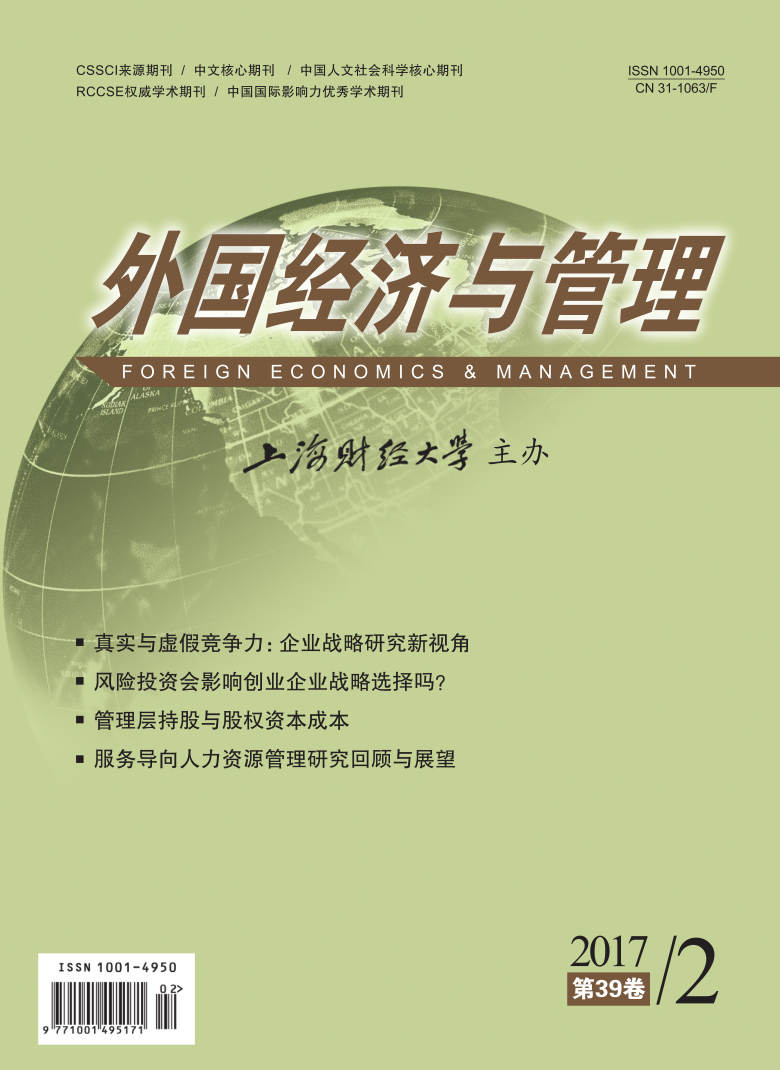组织间依赖指组织单元之间彼此影响的程度,是组织权力的来源。作为对资源依赖理论的重要拓展和补充,组织间依赖对理解组织间竞争与合作关系也具有重要意义。本文在梳理过往研究的基础上,首先将组织间依赖的内涵界定为组织间彼此影响与产生需求的一种现象,依赖程度的不同决定了组织权力的大小;并从联合依赖与不对称依赖、结构依赖与过程依赖、对称依赖与非对称依赖三个角度讨论了组织间依赖的维度划分,梳理和评述了相应的影响因素与结果变量,尤其是依据二元交易关系和焦点企业研究视角的不同,对基于交换理论的联合依赖与不对称依赖的结果变量进行了系统归类和述评;最后,本文提出了组织间依赖未来研究的几个发展方向,希望为组织间依赖乃至资源依赖理论的后续研究提供启示。
组织间依赖研究述评与展望
摘要
参考文献
9 Aggarwal V A, Siggelkow N, Singh H. Governing collaborative activity:Interdependence and the impact of coordination and exploration[J]. Strategic Management Journal, 2011, 32(7):705-730. DOI:10.1002/smj.v32.7
10 Anderson E, Weitz B. Determinants of continuity in conventional industrial channel dyads[J]. Marketing Science, 1989, 8(4):310-323. DOI:10.1287/mksc.8.4.310
11 Bae J, Gargiulo M. Partner substitutability, alliance network structure, and firm profitability in the telecommunications industry[J]. Academy of Management Journal, 2004, 47(6):843-859. DOI:10.2307/20159626
12 Blau P M. Exchange and power in social life[M]. New Brunswick, NJ:Transaction Publishers, 1964.
13 Buchanan L. Vertical trade relationships:The role of dependence and symmetry in attaining organizational goals[J]. Journal of Marketing Research, 1992, 29(1):65-75. DOI:10.2307/3172493
14 Casciaro T, Piskorski M J. Power imbalance, mutual dependence, and constraint absorption:A closer look at resource dependence theory[J]. Administrative Science Quarterly, 2005, 50(2):167-199.
15 Davis G F, Cobb J A. Resource dependence theory:Past and future[J]. Research in the Sociology of Organizations, 2010, 28(1):21-42.
16 Drees J M, Heugens P P. Synthesizing and extending resource dependence theory:A meta-analysis[J]. Journal of Management, 2013, 39(6):1666-1698. DOI:10.1177/0149206312471391
17 Emerson R M. Power-dependence relations[J]. American Sociological Review, 1962, 27(1):31-41. DOI:10.2307/2089716
18 Ganesan S. Determinants of long-term orientation in buyer-seller relationships[J]. Journal of Marketing, 1994, 58(2):1-19. DOI:10.2307/1252265
19 Gulati R, Lavie D, Singh H. The nature of partnering experience and the gains from alliances[J]. Strategic Management Journal, 2009, 30(11):1213-1233. DOI:10.1002/smj.v30:11
20 Gulati R, Sytch M. Dependence asymmetry and joint dependence in interorganizational relationships:Effects of embeddedness on a manufacturer's performance in procurement relationships[J]. Administrative Science Quarterly, 2007, 52(1):32-69.
21 Gulati R, Sytch M. Does familiarity breed trust? Revisiting the antecedents of trust[J]. Managerial and Decision Economics, 2008, 29(2-3):165-190. DOI:10.1002/(ISSN)1099-1468
22 Hambrick D C, Humphrey S E, Gupta A. Structural interdependence within top management teams:A key moderator of upper echelons predictions[J]. Strategic Management Journal, 2015, 36(3):449-461. DOI:10.1002/smj.2230
23 Heide J B. Interorganizational governance in marketing channels[J]. Journal of Marketing, 1994, 58(1):71-85. DOI:10.2307/1252252
24 Heide J B, John G. The role of dependence balancing in safeguarding transaction-specific assets in conventional channels[J]. Journal of Marketing, 1988, 52(1):20-35. DOI:10.2307/1251683
25 Hillman A J. Politicians on the board of directors:Do connections affect the bottom line?[J]. Journal of Management, 2005, 31(3):464-481. DOI:10.1177/0149206304272187
26 Hillman A J, Withers M C, Collins B J. Resource dependence theory:A review[J]. Journal of Management, 2009, 35(6):1404-1427. DOI:10.1177/0149206309343469
27 Hoetker G, Swaminathan A, Mitchell W. Modularity and the impact of buyer-supplier Relationships on the survival of suppliers[J]. Management Science, 2007, 53(2):178-191. DOI:10.1287/mnsc.1060.0630
28 Katila R, Rosenberger J D, Eisenhardt K M. Swimming with sharks:Technology ventures, defense mechanisms and corporate relationships[J]. Administrative Science Quarterly, 2008, 53(2):295-332. DOI:10.2189/asqu.53.2.295
29 Kumar N, Scheer L K, Steenkamp J B E M. The effects of perceived interdependence on dealer attitudes[J]. Journal of Marketing Research, 1995, 32(3):348-356. DOI:10.2307/3151986
30 Lawler E J, Thye S R, Yoon J. Social exchange and micro social order[J]. American Sociological Review, 2008, 73(4):519-542. DOI:10.1177/000312240807300401
31 Lawler E J, Yoon J. Commitment in exchange relations:Test of a theory of relational cohesion[J]. American Sociological Review, 1996, 61(1):89-108. DOI:10.2307/2096408
32 Lee S H, Mun H J, Park K M. When is dependence on other organizations burdensome? The effect of asymmetric dependence on internet firm failure[J]. Strategic Management Journal, 2015, 36(13):2058-2074. DOI:10.1002/smj.2015.36.issue-13
33 Lomi A, Pattison P. Manufacturing relations:An empirical study of the organization of production across multiple networks[J]. Organization Science, 2006, 17(13):313-332.
34 Madhok A. Revisiting multinational firms' tolerance for joint ventures:A trust-based approach[J]. Journal of International Business Studies, 1995:26(1):117-137. DOI:10.1057/palgrave.jibs.8490168
35 Madhok A, Tallman S B. Resources, transactions and rents:Managing value through interfirm collaborative relationships[J]. Organization Science, 1998, 9(3):326-339. DOI:10.1287/orsc.9.3.326
36 Mallapragada G, Grewal R, Mehta R, et al. Virtual interorganizational relationships in business-to-business electronic markets:Heterogeneity in the effects of organizational interdependence on relational outcomes[J]. Journal of the Academy of Marketing Science, 2015, 43(5):610-628. DOI:10.1007/s11747-014-0411-8
37 Ozcan P, Eisenhardt K M. Origin of alliance portfolios:Entrepreneurs, network strategies, and firm performance[J]. Academy of Management Journal, 2009, 52(2):246-279. DOI:10.5465/AMJ.2009.37308021
38 Parkhe A. Interfirm diversity, organizational learning, and longevity in global strategic alliances[J]. Journal of International Business Studies, 1991, 22(4):579-601. DOI:10.1057/palgrave.jibs.8490315
39 Pfeffer J, Nowak P. Joint ventures and interorganizational interdependence[J]. Administrative Science Quarterly, 1976, 21(3):398-418. DOI:10.2307/2391851
40 Pfeffer J, Salancik G R. The external control of organizations:A resource dependence perspective[M]. New York:Harper & Row, 1978.
41 Pfeffer J, Salancik G R. The external control of organizations:A resource dependence perspective[M]. Palo Alto, CA:Stanford University Press, 2003.
42 Suh T, Houston M B. Distinguishing supplier reputation from trust in buyer-supplier relationships[J]. Industrial Marketing Management, 2010, 39(5):744-751. DOI:10.1016/j.indmarman.2010.02.013
43 Thompson J D. Organizations in action:Social science bases of administrative theory[M]. New Brunswick, NJ:Transaction Publishers, 1967.
44 Williamson O E. The economic institutions of capitalism:Firms, markets, relational contracting[M]. New York:Free Press, 1985.
45 Wong S S, Ho V T, Lee C H. A power perspective to interunit knowledge transfer:Linking knowledge attributes to unit power and the transfer of knowledge[J]. Journal of Management, 2008, 34(1):127-150.
46 Xia J. Mutual dependence, partner substitutability, and repeated partnership:The survival of cross-border alliances[J]. Strategic Management Journal, 2011, 32(3):229-253. DOI:10.1002/smj.v32.3
引用本文
吕文晶, 陈劲, 汪欢吉. 组织间依赖研究述评与展望[J]. 外国经济与管理, 2017, 39(2): 72–85.
导出参考文献,格式为:
上一篇:管理层持股与股权资本成本





 9643
9643  17138
17138

